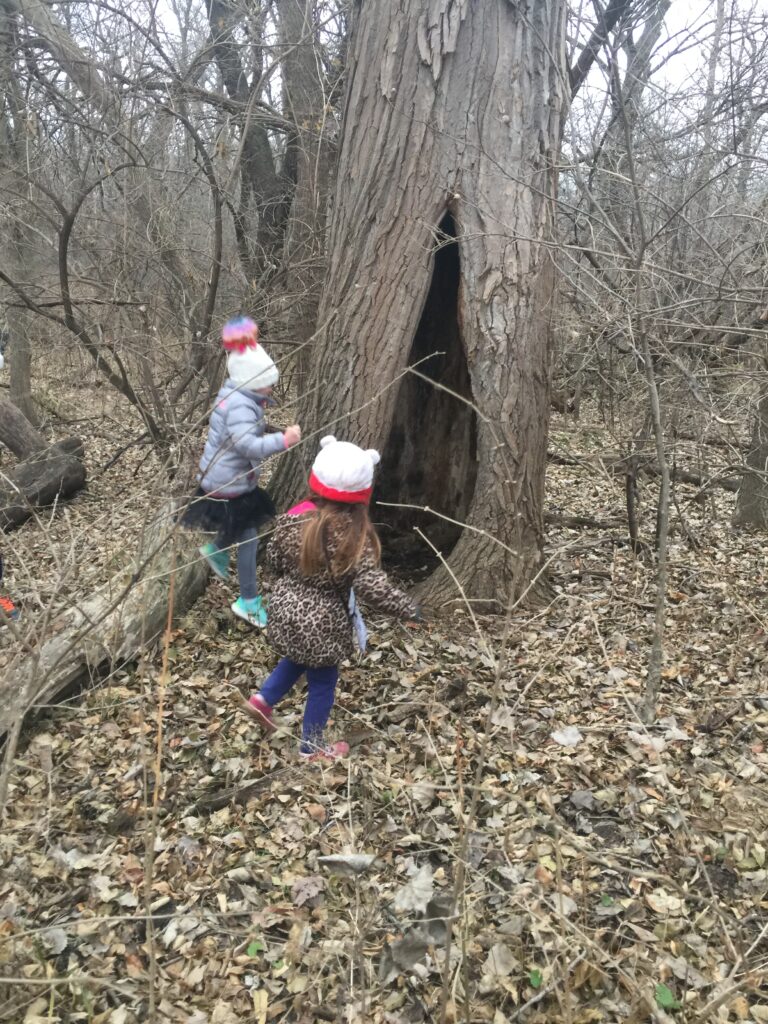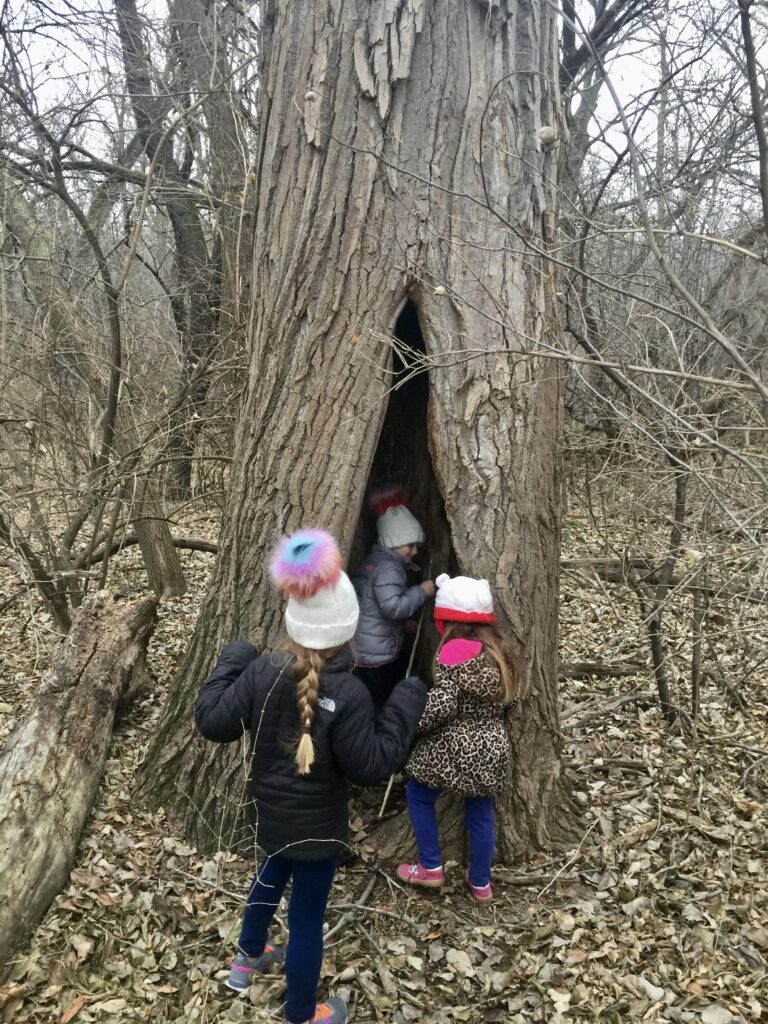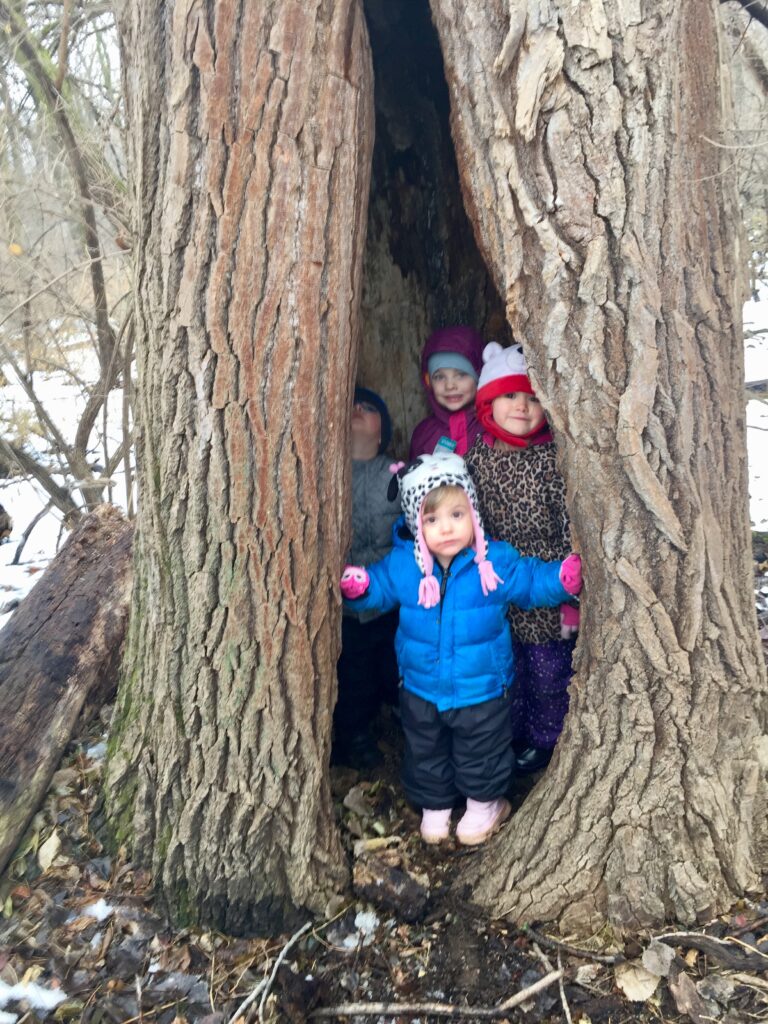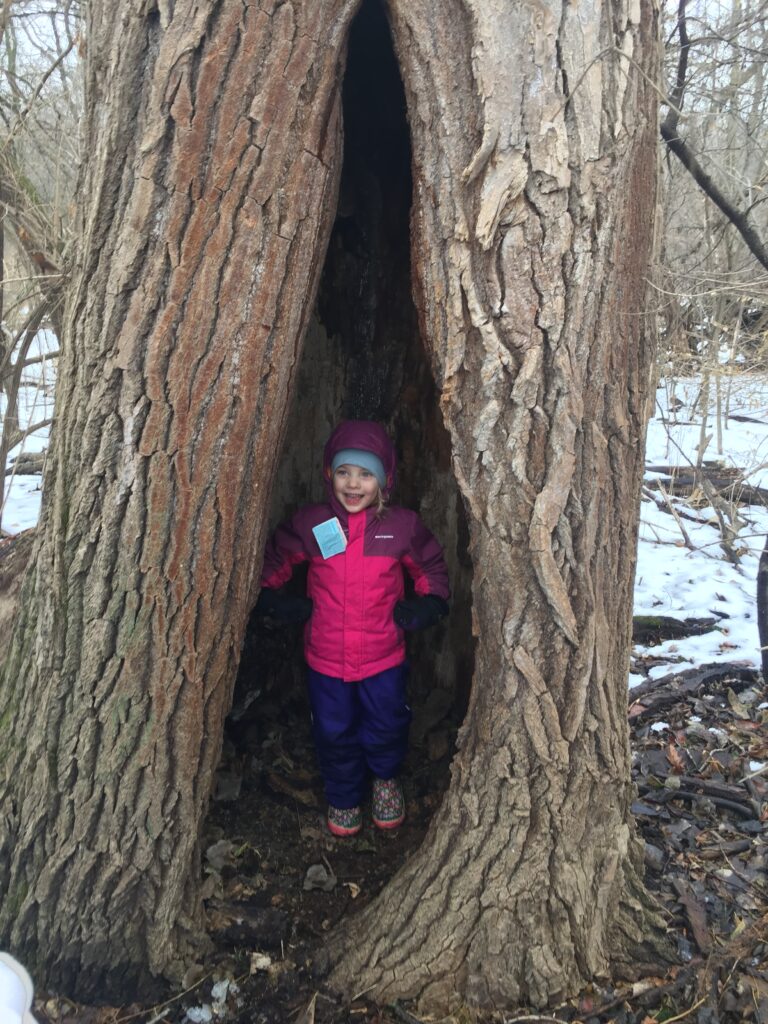Risk-Taking, Math and a Hollow Tree
“LOOK!” Ellie summons us with such joy that there’s no doubt she has spotted something wonderful.
Our eyes follow the four-year-old as she dashes to a very large, very hollow tree. A tree that is still alive and thriving—with an opening over four feet tall just inviting a group of children and their teacher to peek inside.
“Who lives in there?” asks Clare as she summons up the courage to move closer.
Can we go inside the tree?” asks Veronica, although the question is a rhetorical one because the three-year-old has no intention of venturing inside.
“Is the tree hollow all the way up to the top?” Alex asks in wonder as he approaches the tree and glances upward to assess the tree’s height.
“I think a whole family of squirrels might live in there . . . or bats!” Harper’s pronouncement prompts her peers to quickly back away from the tree.
It’s so quiet and still as everyone contemplates the hollow tree that I’m not sure if the children are even breathing. All eyes are locked on Ellie, our resident risk-taker.

Emboldened by the children’s curiosity, Ellie inches her way closer to the tree’s interior. She is cautious but curious, brave yet apprehensive as she simultaneously challenges herself and calculates the risk at hand.
Research tells us that children won’t take risks if they think they can’t succeed. But I know Ellie. She is an amazing observer and a visual learner who tends to rely on her senses when approaching an unfamiliar situation.
Today is no different. I watch as Ellie inspects the size, strength and thickness of the trunk. She inspects the ground outside of the tree cavity for animal droppings. She pokes her head into the hole and peers up, down, left and right before stepping inside. Ellie thrives on moments like these and trusts herself to evaluate the situation.
I trust Ellie as much as she trusts herself. These moments of risk-taking and assessment help a child develop cognitive, social-emotional, and self-regulatory skills—traits that make Ellie a natural leader.

Suddenly, Ellie pops back out of the hole in the tree, looks around and beams at the rest of us. “It’s so cool!” she exclaims. “You have to come in!”
One by one, slowly but surely, the children all make their way into this amazing gift from Mother Nature. Children grow in their ability to appraise risk by observing other children at play.
When children observe their friends taking risks and succeeding, they become more confident about taking risks themselves. This confidence carries over to the classroom and prepares them to try something new, possibly fail, and try again.

This hollow tree trunk has evoked wonder and curiosity in the entire gang, sparking a STEM investigation that helps lay the foundation for later math, science, and engineering concepts.
When we let children learn through play, movement, and trial and error, we lay the groundwork for the kind of deep learning that builds new neural connections. These are the moments that inspire our early learners to investigate the possibilities.
Today, nature has provided the ultimate learning tool and transformed a moment of outdoor play into an exploration of the concepts of spatial relationships and geometry. An understanding of spatial relationships helps children talk about where things are located. I hear them use words such as in, out, down, over, under and next to, vocabulary that helps lay the foundation for geometry.
When children use words such as wide, heavy and light, they are using descriptors for measurement. We begin to get a better sense of measurement as we visually estimate the height of the tree, the height of the entrance hole, and the number of friends who might be able to fit inside the tree.
When children are guessing, predicting and classifying their ideas, they are engaging in early algebra, the scientific method, and basic engineering design. This morning of play is strengthening their understanding of these concepts as they use the vocabulary words repeatedly throughout their investigation.
Hands-on learning enables children to take their understanding to a deeper level so that they can analyze the information that they have collected and then apply this knowledge when they create their own structures during block play, art projects and clay play.
These are opportunities that are rich in learning, creativity and friendship. Whether they are on the playground or in the classroom, children must take risks that enable them to develop new skills and explore their ideas in a safe and supportive environment.
Look for opportunities that can build your student’s risk-taking skills. Like our exploration of the hollow tree, these learning adventures will not only build their confidence and self-esteem but lay the foundation for academic success!

I loved the way the story was set up to read and it flowed so evenly. I actually felt as if I was among them. Ellie is the one with an open mind for a child of age very curious wanted to check it out and never stopped wanting to know more. That is problem solving to me.
Thank you, Bette. Curiosity and time in childhood can lead us to very magical places. I’m glad you enjoyed it.
what a great way to explain a story!
I love this!!!! Just like the 4-minute mile, one succeeds and others follow!!! <3
I really enjoyed this, what a great story, it was a wonderful, thrilling time for this little girl.
I almost felt like I was there will a little girl, such a good story!
Very interesting observations
Beautiful observations and conclusions
So interesting how one brave person can help others to be brave
Early Math is a must for children to become well-rounded individuals and I will use these fun ideas more. Children are sometimes braver than adults!
great to see hoe she was so interested and how it can be contagious for pother children to want to join in the fun and also learning process. they may also want to go back and see the difference in the tree in another season.
I love this story. I love childrens curiosity. I also love how she invited her no so adventurous friends to come look inside. So much learning was happening.
I love how the children are so helpful to another and teaching one another how to be brave .